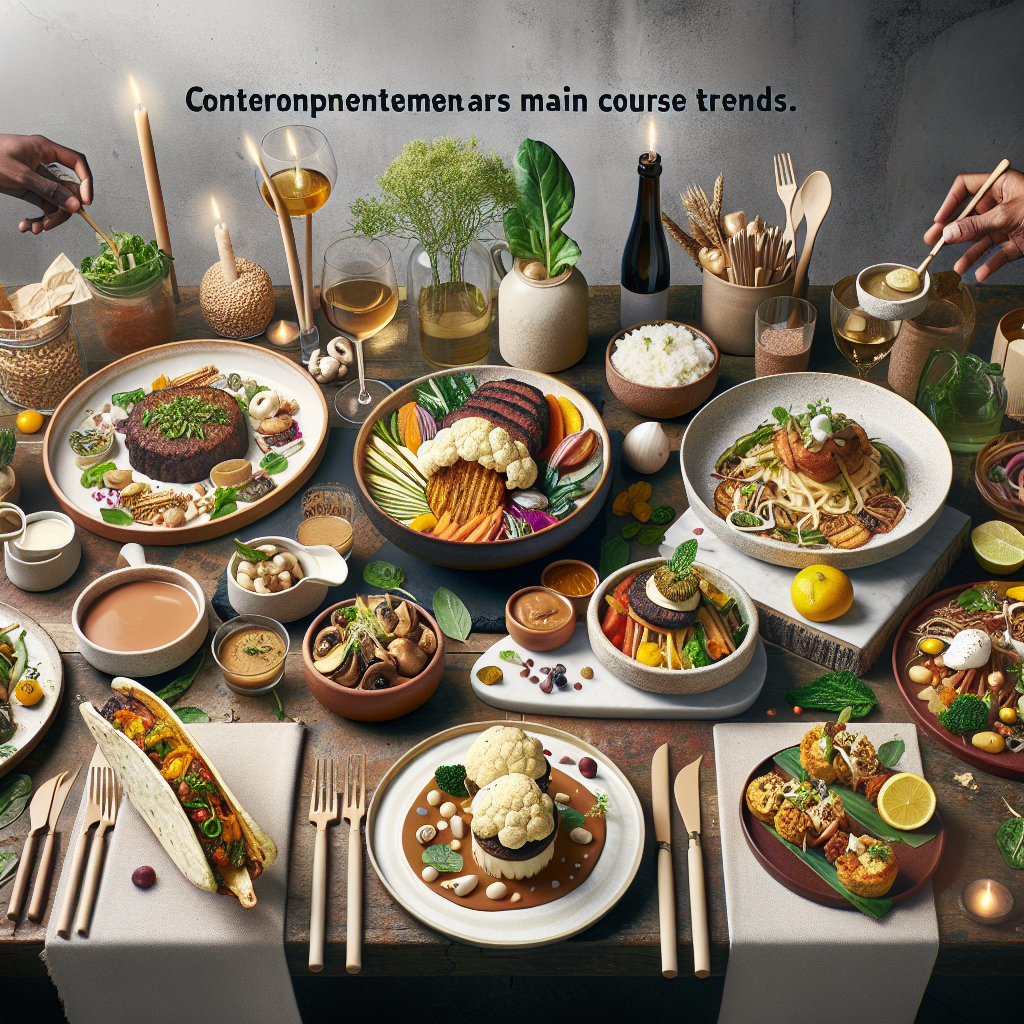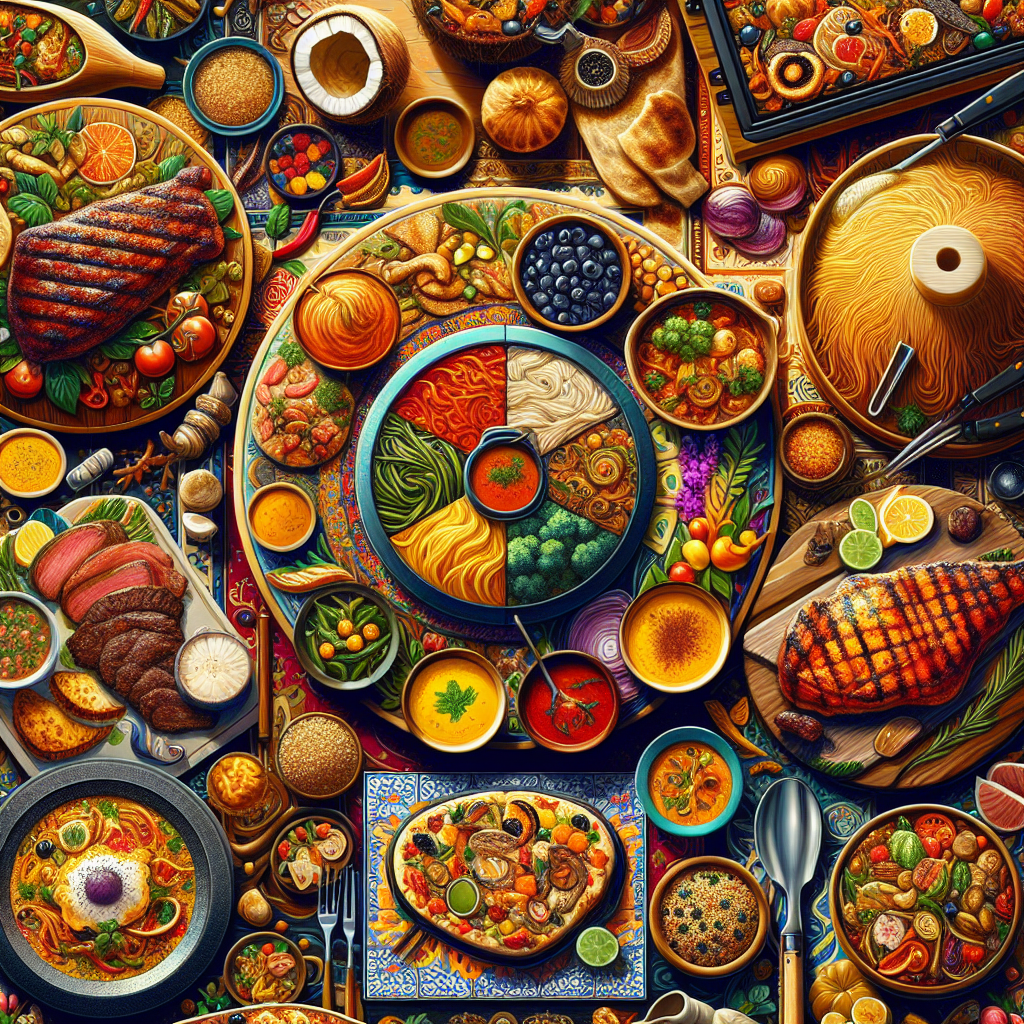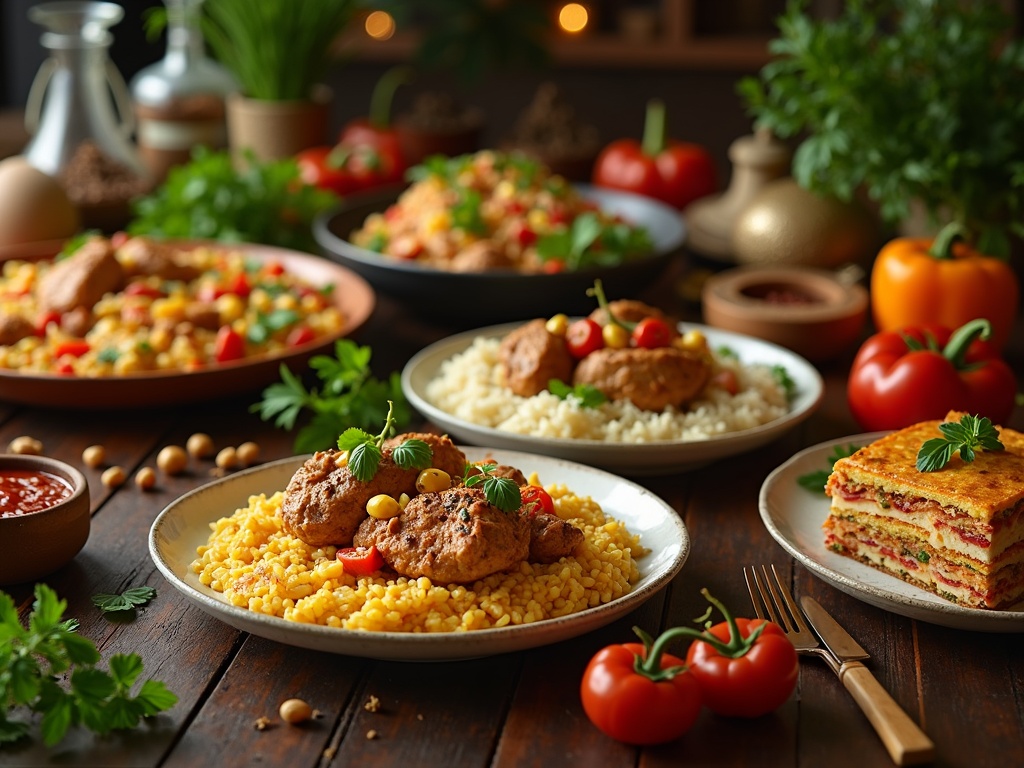The main course forms the core of any meal, acting as the centerpiece that provides key nutrition through balanced mixtures of proteins, carbohydrates, and vitamins. From creamy chicken korma highlighting South Asian spices to authentic paella showcasing Spain’s coastal abundance, main courses mirror cultural identity while fulfilling nutritional, cultural, and emotional needs.
Find In This Article
Key Takeaways
- Main courses typically account for 25-40% of total meal calories and feature substantial protein sources anchored by complementary carbohydrates.
- Portion control is crucial for a balanced meal, with recommendations of 3-6 ounces of protein or 1 cup of grains/vegetables per person.
- Plant-based main courses have moved into the mainstream, with over 40% of Americans incorporating weekly plant-based meals into their diets.
- Fusion cuisine that blends culinary traditions is creating innovative main courses that respect foundational techniques while developing new flavor combinations.
- Dietary adaptations for main courses don’t require sacrificing flavor, with simple swaps like legumes, tofu, or mushrooms creating satisfying alternatives.
What Makes a Main Course Special
The main course forms the heart of any meal, accounting for 25-40% of total meal calories. I’ve found this substantial portion makes perfect sense, as the main dish serves as the focal point around which the entire dining experience revolves.
Nutritional and Cultural Significance
Main courses deliver essential nutrition through a balanced combination of proteins, carbohydrates, and vital vitamins. This isn’t just about filling up—it’s about providing sustained energy and nutritional value in a single, central dish. In fine dining circles, you’ll hear the main course referred to as the “entrée,” highlighting its importance in the meal progression between appetizers and desserts.
What makes main courses truly special is how they reflect cultural identity through their ingredients and preparation methods. For example, creamy chicken korma showcases the aromatic spice combinations central to South Asian cooking, while authentic paella captures Spain’s coastal bounty in a single pan.
Key Components of Memorable Main Dishes
The most satisfying main courses typically feature:
- Substantial protein sources: Whether it’s a tender beef curry simmered for hours or a flaky fish curry in aromatic sauce, protein anchors the dish.
- Complementary carbohydrates: Rice, potatoes, pasta, or bread that help round out the meal.
- Depth of flavor: Developed through proper seasoning, cooking techniques, and complementary ingredients.
- Visual appeal: Thoughtful presentation that entices before the first bite.
- Textural contrast: Crispy elements paired with tender components create interest.
I’ve noticed the most beloved main courses often tell a story through their ingredients. Take butter chicken for instance—its rich tomato-based sauce with warm spices creates a deeply satisfying experience that reflects its North Indian origins.
Cultural variations make main courses particularly fascinating. While Italian cuisine celebrates pasta as its centerpiece, Japanese tradition elevates precisely prepared sushi, and Indian cooking showcases complex curries. Even fusion dishes like chicken lasagna demonstrate how main courses evolve through cultural exchange.
The special status of main courses comes from their ability to satisfy on multiple levels—nutritionally, culturally, and emotionally—making them the true stars of any meal.
Mastering Main Course Portions and Preparation
The centerpiece of any meal is undoubtedly the main course. I’ve found that nailing the right portion size and cooking method can transform an ordinary dish into something spectacular. Let me share some guidelines that’ll help you create perfectly balanced main courses.
Portion Control Guidelines
Getting portions right is crucial for a satisfying meal. For meat-based dishes, I typically aim for 3-6 ounces per serving – that’s about the size of a deck of cards or the palm of your hand. When preparing a hearty beef curry, this portion size ensures guests feel satisfied without overindulging.
For vegetarian mains, I recommend approximately 1 cup of cooked grains or vegetables per person. This works perfectly when making dishes like a vegetable-packed lasagna where you want to ensure everyone gets enough without leftovers going to waste.
This approach aligns with what diners want – research shows that 70% of consumers actively seek healthier ingredient options when dining out, and balanced portions are a big part of that equation.
Essential Cooking Methods
The cooking technique you choose dramatically affects your main course’s flavor profile and texture:
- Grilling: Perfect for chicken dishes where you want that smoky char
- Roasting: Ideal for larger cuts of meat or whole vegetables
- Baking: Great for casseroles and one-pot rice dishes
- Steaming: Preserves nutrients in delicate fish preparations
- Frying: Creates that irresistible crispy exterior for special occasions
Food safety is non-negotiable, so I always use a meat thermometer to check internal temperatures. For beef, I aim for 145°F (medium-rare), while chicken and other poultry need to reach 165°F. When making a rich butter chicken, ensuring the chicken reaches the proper temperature guarantees both safety and the perfect texture.
A complete main course balances proteins, carbohydrates, and vegetables. This trinity creates nutritional balance while offering complementary flavors and textures. I’ve found that a well-executed main course is about 50% protein, 25% carbohydrates, and 25% vegetables – this ratio creates visual appeal and satisfies diverse nutritional needs.
By mastering these fundamentals, you’ll create main courses that impress with both presentation and flavor, whether you’re cooking for a weeknight family dinner or hosting a special gathering.
Modern Main Course Trends Reshaping Dining
I’ve noticed a significant shift in how people approach their main courses today. The centerpiece of meals is evolving rapidly, moving away from traditional heavy meat-focused dishes toward more diverse, conscious options. These changes reflect broader shifts in our eating habits and values.
Plant-Based Revolution
Plant-based eating has moved firmly into the mainstream. Over 40% of Americans now incorporate weekly plant-based meals into their diets, showing this isn’t just a passing trend but a fundamental shift in eating patterns. The plant-based food market is projected to reach $74 billion by 2027, demonstrating the economic power behind this movement.
This surge has transformed main course options everywhere from home kitchens to fine dining establishments. Cauliflower steaks, mushroom Wellington, and jackfruit pulled “meat” have become staples rather than novelties. I’ve found that plant-based curry alternatives can deliver the same depth of flavor as their meat counterparts when prepared with the right techniques.
The appeal extends beyond just vegans and vegetarians. Flexitarians—those reducing meat consumption without eliminating it entirely—are driving much of this growth. They’re seeking main courses that feature vegetables as the star, not just as sides or garnishes.
Fusion and Global Influences
Another fascinating trend is the rise of fusion cuisine that blends culinary traditions to create innovative main courses. Korean tacos, Japanese-Italian pasta dishes, and Indian-Mexican fusion plates are becoming increasingly popular, breaking down traditional boundaries between cooking styles.
This trend reflects our increasingly connected world and diverse palates. Dishes like butter chicken fusion creations demonstrate how traditional recipes can be reimagined with influences from other cultures.
The most successful fusion main courses respect the foundations of each culinary tradition while creating something genuinely new. I’ve seen chefs combining flavor profiles from across continents—like Mediterranean spices with East Asian techniques—to create unforgettable centerpiece dishes.
Sustainability and Locality
Today’s dining experience increasingly focuses on where ingredients come from and how they impact our planet. This has transformed how main courses are conceptualized and presented.
The farm-to-table movement has evolved from a niche concept to a mainstream approach, with restaurants proudly displaying local farm partnerships on their menus. Many establishments now feature main courses that highlight:
- Seasonal ingredients harvested at peak freshness
- Heritage varieties of vegetables and grains
- Sustainably caught seafood alternatives like locally-sourced fish curry
- Humanely raised animal products
- Zero-waste cooking techniques that utilize entire ingredients
Local sourcing has become particularly important, with many restaurants establishing direct relationships with nearby producers. This approach not only reduces carbon footprints but often results in fresher, more flavorful main courses.
The emphasis on sustainability extends to portion sizes as well. Rather than massive plates dominated by proteins, more restaurants are serving balanced main courses with moderate meat portions complemented by abundant plant foods. Dishes like chicken korma can be reimagined with less meat and more vegetables while maintaining their satisfying appeal.
Even classic comfort foods are getting sustainable makeovers. Traditional dishes like chicken lasagna are being reinvented with local, seasonal vegetables and smaller amounts of high-quality proteins.
Global influences have also expanded sustainable main course options. Mediterranean and Spanish dishes like authentic paella demonstrate how seafood, vegetables, and grains can combine to create spectacular centerpiece dishes that are inherently sustainable.
These trends reflect a broader shift in how we view main courses—not just as the biggest portion of a meal, but as an expression of our values around health, culture, and environmental impact.

Global Flavors and Cultural Influences
I’ve noticed how main courses often reflect cultural heritages while adapting to modern tastes and ingredient availability. Traditional meat dishes remain popular centerpieces that celebrate diverse cooking methods from around the world.
Traditional Protein-Based Main Courses
Grilled chicken stands as one of the most versatile proteins, taking on different personalities depending on its seasoning profile. In Indian cuisine, the marinated chicken in flavorful chicken korma showcases how aromatic spices transform a simple protein into something extraordinary. Similarly, butter chicken represents how a traditional dish can become globally beloved while maintaining its cultural roots.
For red meat enthusiasts, beef steak represents Western culinary traditions with its focus on high-quality cuts and minimal seasoning. Meanwhile, beef curry demonstrates how the same protein can be completely transformed through slow cooking with spices in South Asian traditions.
Seafood offers lighter yet equally satisfying main course options. Baked salmon pairs wonderfully with Mediterranean ingredients like lemon, capers, and olive oil. For more complex flavors, fish curry introduces coconut milk and aromatic spices that elevate the dining experience.
Plant-Based and Fusion Innovations
Plant-forward main courses have evolved far beyond basic options. Pasta primavera celebrates seasonal vegetables in a light sauce, while hearty quinoa bowls can be customized with regional ingredients from Mediterranean to Mexican influences.
The beauty of fusion cuisine lies in its creative combinations. Chicken lasagna perfectly illustrates this concept, merging Italian pasta techniques with protein preparations from other traditions. The Spanish paella has inspired countless variations worldwide, with each culture adding local ingredients while maintaining the dish’s essence.
Regional variations make these global dishes unique:
- Mediterranean regions emphasize olive oil, tomatoes, and herbs like basil and oregano
- East Asian cuisines often feature soy, ginger, and specialized cooking techniques like stir-frying
- Latin American dishes incorporate chilis, corn, and beans with distinctive preparation methods
- Middle Eastern main courses showcase aromatic spices, grains, and slow-cooking techniques
Cultural cooking methods significantly impact flavor development. Whether it’s the tandoor clay oven of India, Japanese robata grilling, or American barbecue smoking techniques, these traditional approaches create distinctive taste profiles that can’t be replicated with modern shortcuts.
By exploring these global influences, I’ve found that main courses serve as delicious cultural ambassadors that bring the world’s diverse flavors to our tables.

Dietary Adaptations and Alternatives
Changing a main course to fit special dietary needs doesn’t mean sacrificing flavor. I’ve found that with a few simple swaps and cooking method adjustments, you can create meals that accommodate everyone at the table without making them feel like they’re missing out on the full culinary experience.
Customizing Your Main Course for Dietary Needs
When adapting recipes for gluten-free diets, I rely on several grain substitutions that maintain the dish’s integrity. Rice is perhaps the most versatile option, working beautifully in dishes from Spanish paella to stir-fries. Quinoa offers a protein-rich alternative that holds up well as a base for main courses, while polenta brings a comforting texture to plates that might otherwise feature pasta. Cauliflower rice has become my go-to for lighter options, and certified gluten-free oats can transform into savory porridges topped with roasted vegetables.
For those following plant-based diets, protein options have expanded dramatically in recent years. These alternatives ensure satisfying main courses without animal products:
- Legumes like lentils, beans, and chickpeas form the foundation of many protein-rich vegan dishes
- Tofu and tempeh absorb flavors beautifully when marinated properly
- Seitan (wheat gluten) provides a meaty texture for those without gluten restrictions
- Jackfruit mimics pulled meat textures when properly prepared
- Mushrooms (especially portobello and king oyster varieties) deliver umami depth
I’ve created some standout vegan main courses using these ingredients. Curries are particularly adaptable – swap fish for chickpeas and coconut milk for a creamy base that satisfies even dedicated carnivores. My spiced chickpea stew with tomatoes and spinach delivers warming comfort with minimal effort. For more structured dishes, try stuffed bell peppers with quinoa and black beans or a hearty lasagna using thinly sliced zucchini instead of pasta sheets.
Cooking methods often need adjustment for dietary restrictions. For low-fat diets, I’ve found air frying and steaming preserve flavor while reducing oil. Those with sodium restrictions benefit from herb-forward cooking techniques – infusing oils with fresh herbs before cooking imparts tremendous flavor without salt. Pressure cooking can tenderize tougher plant proteins like beans in a fraction of the time, making weeknight curry preparations feasible.
Customization becomes simple once you identify adaptable base recipes. Chicken korma can easily transform into a vegetarian dish by substituting cauliflower and chickpeas for the chicken while maintaining the aromatic sauce. Similarly, butter chicken can become a dairy-free delight using coconut cream instead of heavy cream and tofu in place of chicken.
When adapting recipes, I pay close attention to nutritional considerations. Plant-based diets might require iron supplementation through ingredients like spinach or pumpkin seeds. For those avoiding dairy, calcium-rich alternatives like fortified plant milks and tofu help maintain bone health. Gluten-free diets sometimes lack fiber, making the addition of chia seeds, flaxseeds, and abundant vegetables important for digestive health.
The beauty of dietary adaptations lies in their ability to expand your culinary horizons rather than restrict them. By embracing alternative ingredients and cooking methods, you’ll discover new flavor combinations and textures that might become favorites regardless of dietary needs. I’ve found that these adaptations often lead to more creative, nutritious, and colorful plates that everyone can enjoy together.
Sources:
Food and Nutrition Research Journal – The Role of Main Courses in Modern Dining
Culinary Institute of America – Trends in Meal Composition
National Restaurant Association Report 2023 – The Rise of Plant-Based Diets

